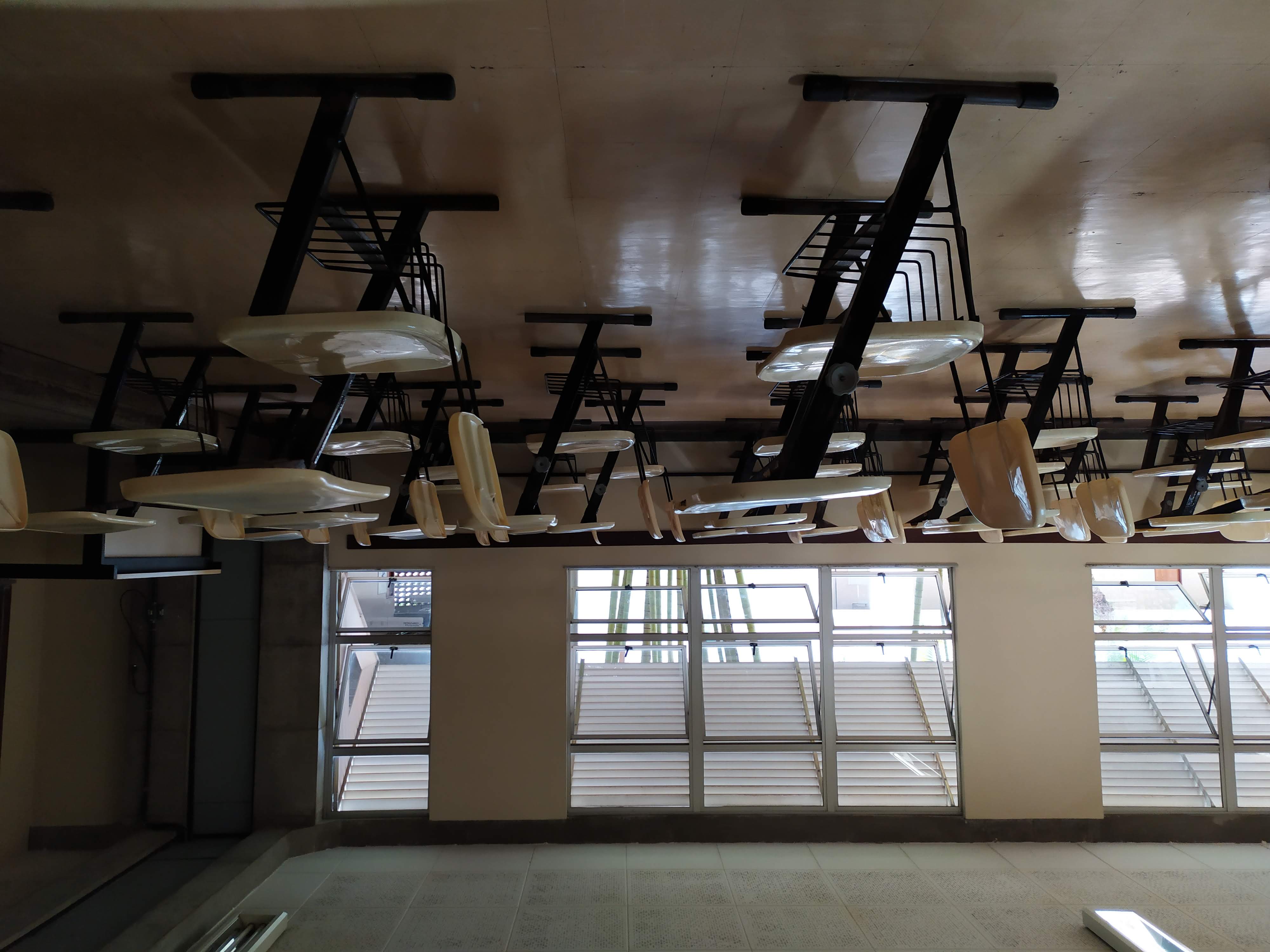This summer, I attended The Summer Program in Mathematics, UFMG 2023 and I took the Introduction of Probability Theory course (Professor: Bernando Nunes Borges de Lima (UFMG)), below you can find the first test of the course with the answers, made by me .
\[ \]
Question 1
Let \(\mathbf{A}_n\) and \(\mathbf{B}_n\) be a sequence of random events from the same probability space such that \(\mathbb{P}(\mathbf{A}_n)\rightarrow 1\) and \(\mathbb{P}(\mathbf{B}_n)\rightarrow p\). Show that \(\mathbb{P}(\mathbf{A}_n \cap \mathbf{B}_n)\rightarrow p\).
Solution:
\[\begin{equation*} \begin{array}{rclll} \mathbb{P}(\mathbf{A}_n \cap \mathbf{B}_n) & = & \mathbb{P}(\mathbf{B}_n) - \mathbb{P}(\mathbf{A}^{c}_n \cap \mathbf{B}_n) \end{array} \end{equation*}\]
E como: \[\begin{equation*} \begin{array}{rclll} & & (\mathbf{A}_n \cap \mathbf{B}_n) & \subset & \mathbf{A}^{c}_n \hspace{2ex} \mbox{para todo} \hspace{2ex} n \in \mathbb{N}, \hspace{2ex} \mbox{temos que} \hspace{2ex} \\ 0 & \leq & \mathbb{P}(\mathbf{A}^{c}_n \cap \mathbf{B}_n) & \leq & \mathbb{P}(\mathbf{A}^{c}_n) \hspace{2ex} \mbox{em que} \hspace{2ex} \\ & & & & \mathbb{P}(\mathbf{A}^{c}_n){\underset{n \to \infty}{\longrightarrow}} 0 \hspace{2ex} \mbox{e portanto,} \hspace{2ex} \\ & & \mathbb{P}(\mathbf{A}_n \cap \mathbf{B}_n) & = & \mathbb{P}(\mathbf{B}_n) - \mathbb{P}(\mathbf{A}^{c}_n \cap \mathbf{B}_n){\underset{n \to \infty}{\longrightarrow}} p - 0 \; = \; p \end{array} \end{equation*}\]
Question 2
Let \(\mathbf{X}\) have density \(f_{X}(x) = x^{-2}\cdot\mathbb{1}_{\{(-\infty,-2]\cup [2,\infty))\}}\).
(a) Show that for all \(z \geq 0\), \(\mathbb{P}(X>z) = \mathbb{P}(X<-z)\).
Solution
\[\begin{equation*} \begin{array}{rclll} \mathbb{P}(X>z) & = & \displaystyle\int_{z}^{\infty}\dfrac{1}{x^2}dx \; = \; -x^{-1} \Bigr\rvert_{z}^{\infty} \; = \; z^{-1} \\[15pt] \mathbb{P}(X<-z) & = & \displaystyle\int_{-\infty}^{-z}\dfrac{1}{x^2}dx \; = \; -x^{-1} \Bigr\rvert_{-\infty}^{-z} \; = \; z^{-1} \\[15pt] \end{array} \end{equation*}\]
Therefore, we have that \(\mathbb{P}(X>z) = \mathbb{P}(X<-z)\).\
(b) What can we say about the expectation of \(X\)? (Hint: Calculate \(\displaystyle\int_{0}^{\infty}\mathbb{P}(X>z)dz\))
Solution
\[\begin{equation*} \begin{array}{rclll} \mathbb{E}(X) & = & \displaystyle\int_{z}^{\infty}\mathbb{P}(X>z) dz - \displaystyle\int_{-\infty}^{-z}\mathbb{P}(X<-z)dz \\[15pt] & = & \displaystyle\int_{2}^{\infty}\dfrac{1}{z} dz - \displaystyle\int_{-\infty}^{-2}\dfrac{1}{z}dz \\[15pt] & = & \ln{(z)} \Bigr\rvert_{2}^{\infty} - \ln{(|z|)} \Bigr\rvert_{-\infty}^{-2} \; = \; \infty - \infty \\[15pt] \end{array} \end{equation*}\]
Therefore, the expectation of \(X\) is not well defined since the expected value of both parts diverges, \(\mathbb{E}(X) > \infty\).
Question 3
Let \(\mathbf{Q}\) the square of vertices (+1,0), (-1,0), (0,+1), (0,-1) and \((X,Y)\) the vector with joint density \[\begin{equation*} \begin{array}{lclll} f_{X,Y}(x,y) & = & \dfrac{ \mathbb{1}_{\mathbf{Q}}(x,y) }{2}. \end{array} \end{equation*}\] Are the variables \(X\) and \(Y\) independent?
Solution
We have that the margins of \(X\) and \(Y\) are given by: For \(X\), we have:
\[\begin{equation*} \begin{array}{lclll} f_{X}(x) & = & \begin{cases} \displaystyle\int_{-x-1}^{1+x} \dfrac{1}{2}dy, & \text{se $-1\leq x < 0$} \\[15pt] \displaystyle\int_{x-1}^{1-x} \dfrac{1}{2}dy, & \text{se $0\leq x \leq 1$} \end{cases} \end{array} \end{equation*}\]
in which: \[\begin{equation*} \begin{array}{lclll} f_{X}(x) & = & \begin{cases} 1+x, & \text{se $-1\leq x < 0$} \\[15pt] 1-x, & \text{se $0\leq x \leq 1$} \end{cases} \end{array} \end{equation*}\]
For \(Y\), then:
\[\begin{equation*} \begin{array}{lclll} f_{Y}(y) & = & \begin{cases} 1+y, & \text{se $-1\leq y < 0$} \\[15pt] 1-y, & \text{se $0\leq y \leq 1$} \end{cases} \end{array} \end{equation*}\]
It can be observed, then, from the margins found, that \(X\) and \(Y\) are not independent, since \(f_{X,Y}(x,y) \neq f_{X}(x)\cdot f_{Y }(y)\).
Question 4
In a Bernoulli trial with parameters \(p\), let \(X\) be the variable that denotes the number of trials until we get the 2nd success. Calculate \(\mathbb{E}X\).
Solution
\[\begin{equation*} \begin{array}{lclll} \mathbb{P}(\mathbf{X} = k) = (k-1)p^2(1-p)^{k-2}, & k = 2, 3, \ldots \end{array} \end{equation*}\]
Then,
\[\begin{equation*} \begin{array}{lclllll} \mathbb{E}(\mathbf{X}) & = & \displaystyle\sum_{k=2}^{\infty} k \cdot (k-1) p^2(1-p)^{k-2} \; = \; p^2 \displaystyle\sum_{k=2}^{\infty} k \cdot (k-1) (1-p)^{k-2} \\ \end{array} \end{equation*}\]
Considering now \(\alpha = (1-p)\),
\[\begin{equation*} \begin{array}{lclllll} \displaystyle\sum_{k=2}^{\infty} \dfrac{d^2 \alpha^{k}}{d\alpha^2} \; = \; \dfrac{d^2}{d\alpha^2}\displaystyle\sum_{k=2}^{\infty}\alpha^k \; = \; \dfrac{d^2}{d\alpha^2} \left(\dfrac{\alpha^2}{1-\alpha}\right) \; = \; \dfrac{2}{(1-\alpha)^3} \\ \end{array} \end{equation*}\]
Therefore, \[\begin{equation*} \begin{array}{lclllll} \mathbb{E}(\mathbf{X}) & = & p^2 \cdot \dfrac{2}{p^3} \; = \; \dfrac{2}{p}\\ \end{array} \end{equation*}\]
Question 5
From a common deck we remove 2 cards without replacement, observe how many are clubs, return the cards to the deck and shuffle them again. Then we draw 1, 3 or 5 cards without replacement, depending on whether the number of clubs observed in the 1st step was 0.1 or 2, respectively.
(a) What is the probability that we withdraw 4\(\clubsuit\) in the 2nd step?
Solution
\(\mathbf{A}_{k}\) = { tirei \(k\) cartas de paus}, \(k=0, 1,\) ou \(2\).
\(\mathbf{B}_{l}\) = { retirar \(l\) cartas}, \(l=1, 3,\) ou \(5\).
\(\mathbf{C}\) = { 4\(\clubsuit\) na segunda etapa }
Temos então que: \[\begin{equation*} \begin{array}{lcllllllllll} \mathbb{P}(\mathbf{A}_{0}) & = & \dfrac{39}{52}\cdot\dfrac{38}{51} ; & \mathbb{P}(\mathbf{A}_{1}) & = & 2\cdot\dfrac{39}{52}\cdot\dfrac{13}{51} ; & \mathbb{P}(\mathbf{A}_{2}) & = & \cdot\dfrac{13}{52}\cdot\dfrac{12}{51}\\[15pt] \mathbb{P}(\mathbf{C}|\mathbf{A}_{0}) & = & \dfrac{1}{52} ; & \mathbb{P}(\mathbf{C}|\mathbf{A}_{1}) & = & \dfrac{3}{52} ; & \mathbb{P}(\mathbf{C}|\mathbf{A}_{2}) & = & \dfrac{5}{52} ; &\\ \end{array} \end{equation*}\]
Assim, \[\begin{equation*} \begin{array}{rclrrrlllll} \mathbb{P}(\mathbf{C}) & = & \mathbb{P}(\mathbf{A}_{0})\cdot \mathbb{P}(\mathbf{C}|\mathbf{A}_{0}) + \mathbb{P}(\mathbf{A}_{1})\cdot \mathbb{P}(\mathbf{C}|\mathbf{A}_{1}) + \mathbb{P}(\mathbf{A}_{2})\cdot \mathbb{P}(\mathbf{C}|\mathbf{A}_{2}) \\[15pt] \mathbb{P}(\mathbf{C}) & = & \dfrac{39}{52}\dfrac{38}{51}\cdot\dfrac{1}{52} + 2\dfrac{39}{52}\dfrac{13}{51}\cdot\dfrac{3}{52} + \dfrac{13}{52}\dfrac{12}{51}\cdot\dfrac{5}{52} \\[15pt] \mathbb{P}(\mathbf{C}) & = & \dfrac{19}{2\cdot 17}\cdot\dfrac{1}{52} + \dfrac{13}{2\cdot 17}\cdot\dfrac{3}{52} + \dfrac{1}{17}\cdot\dfrac{5}{52} \; = \; \dfrac{19+3\cdot 13 + 2 \cdot 5}{52\cdot 2 \cdot 17} \; = \; \dfrac{68}{1768} \\[15pt] \mathbb{P}(\mathbf{C}) & = & \dfrac{1}{26} \\[15pt] \end{array} \end{equation*}\]
(b) What is the probability that we drew at least one club in the 1st step given that we drew the 4\(\clubsuit\) in the 2nd step?
Solution
\[\begin{equation*} \begin{array}{rclrrrlllll} \mathbb{P}(\mathbf{A}_{1} \cup \mathbf{A}_{2}|\mathbf{C}) & = & \dfrac{\mathbb{P}(\mathbf{A}_{1})\cdot \mathbb{P}(\mathbf{C}|\mathbf{A}_{1}) + \mathbb{P}(\mathbf{A}_{2})\cdot \mathbb{P}(\mathbf{C}|\mathbf{A}_{2})}{\mathbb{P}(\mathbf{C})}\\[15pt] & = & \dfrac{3\cdot 13 + 2 \cdot 5}{52\cdot 2 \cdot 17} \cdot \dfrac{26}{} = \dfrac{49}{68} \\[15pt] \end{array} \end{equation*}\]
End!
